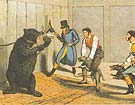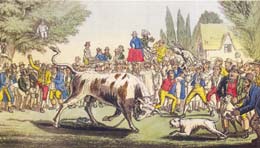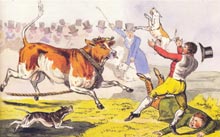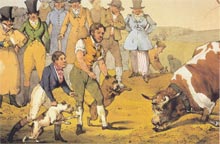"After a coming Bull-baiting had been advertised, the bull, decorated with flowers or coloured ribbons would be paraded round the streets of the town, and the dog which pulled off the favours in the subsequent baiting would be especially cheered by the spectators. The parade ended, the bull, with a rope tied round the root of his horns, would be fastened to a stake with an iron ring in it, situated in the centre of the ring."
As mentioned previously, the first bull runnings in England were supposed to have been at Stamford in the year 1209, in the reign of King John, and at Tutbury in 1374. There are, however, grounds for the belief that bull-baiting began much earlier, and that it was probably first indulged in by butchers who employed their dogs to chase, catch, and throw the bulls, and to bait them so as to render the flesh tender. Moreover, Claudian's writings suggest that the practice of baiting bulls was a form of diversion in his time.
"William, Earl of Warren, Lord of the town, standing upon the walls of the castle saw two bulls fighting for a cow in the castle meadow, until all the butchers' dogs pursued one of the bulls (maddened with noise and multitude) clean through the town. This sight so pleased the Earl, that he gave the castle meadow where the bulls' duel began for a common to the butchers of the town after the first grass was mowed, on condition that they should find a mad bull the day six weeks before Christmas Day, for the continuance of the sport forever."




































